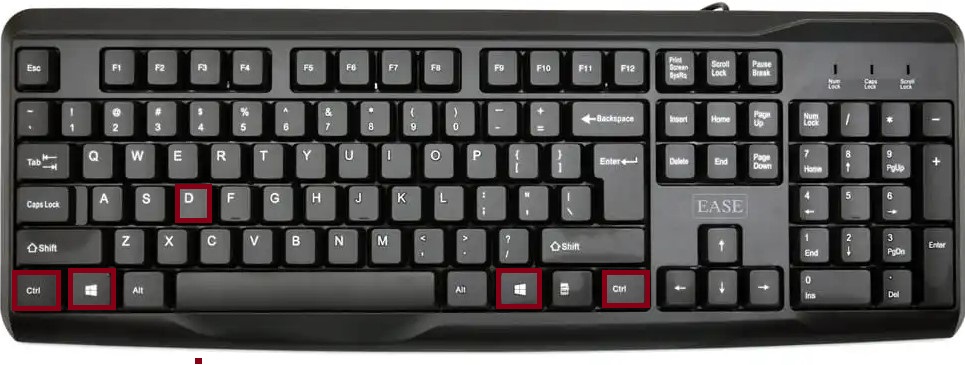The Windows+Ctrl+D keyboard shortcut is a powerful feature in Windows that allows users to create a new virtual desktop instantly. Virtual desktops provide an organized workspace by letting you separate tasks, applications, and windows into different desktop environments without physically adding monitors. This function is part of Windows’ Task View system and is especially valuable for multitaskers, remote workers, and anyone who wants a clutter-free workflow.
In this guide, we’ll explore the use of Windows + Ctrl + D across different scenarios, how it works in Microsoft applications, its uses in other applications, possible issues or reasons it may not work, and the equivalent on other operating systems.
Table of Contents
Function of Windows+Ctrl+D
When you press Windows + Ctrl + D:
- Windows instantly creates a new virtual desktop.
- Your view switches to that newly created desktop automatically.
- The new desktop starts with no open windows, giving you a clean workspace.
- All your other open desktops remain available and can be accessed via Windows + Ctrl + Left/Right Arrow or Task View.

This feature is available in Windows 10 and Windows 11.
Use in Microsoft Applications
While Windows + Ctrl + D works at the OS level rather than within specific applications, it can be extremely useful when working with Microsoft Office and other Microsoft tools:
- Microsoft Word – Create a separate virtual desktop for editing large documents while keeping research materials on another desktop.
- Microsoft Excel – Use one desktop for your data entry work and another for data analysis or report creation.
- Microsoft PowerPoint – Keep presentation design in one desktop and resource gathering (images, references) in another.
- Microsoft Outlook – Have emails and scheduling open in a dedicated desktop while keeping your main work area distraction-free.
- Microsoft Teams – Use one desktop for calls and chats, and another for focused work without notifications popping up in your face.
This separation of workspaces prevents clutter and helps maintain focus.
Use in Other Applications
The Windows+Ctrl+D shortcut works equally well outside Microsoft apps. Here’s how it can help in different environments:
Web Browsers (Chrome, Edge, Firefox)
- One desktop can be used exclusively for work-related browsing (e.g., research, company tools).
- Another desktop can be used for personal browsing or entertainment without mixing tabs.
Creative Software (Photoshop, Premiere Pro, etc.)
- Keep editing software open in one desktop, and asset folders or browser-based resources open in another.
Coding and Development Tools
- Have your IDE (Visual Studio, VS Code) open in one desktop and documentation or testing tools in another.
- This avoids window overlap and speeds up workflow switching.
Gaming
- Keep a game running in one desktop and quickly switch to another desktop for browsing, streaming, or chatting without minimizing the game.
Managing Virtual Desktops
Once you’ve created a new desktop with Windows + Ctrl + D, you can:
- Switch between desktops: Windows + Ctrl + Left/Right Arrow
- Close a desktop: Windows + Ctrl + F4 (closes the current desktop, moves windows to the previous one)
- View all desktops: Windows + Tab (Task View)
FAQs
If Windows + Ctrl + D is not working, possible reasons include:
- Windows Version – Virtual desktops are available only in Windows 10 and later.
- Keyboard Shortcuts Disabled – Some enterprise or school computers may disable certain shortcuts via Group Policy.
- Keyboard Issues – Faulty keys or incorrect keyboard layout may prevent detection of the shortcut.
- Third-Party Software Conflict – Some screen management or macro tools override Windows shortcuts.
Fixes:
- Ensure your Windows version supports virtual desktops.
- Check keyboard functionality and layout.
- Open Settings > System > Multitasking to confirm virtual desktops are enabled.
Mac Equivalent
On macOS, the equivalent is to create a new Space (Apple’s version of virtual desktops):
- Press Control + Up Arrow to open Mission Control.
- Click the + button in the top-right corner to add a new desktop.
Alternatively, use a four-finger swipe up on a trackpad to access Mission Control.
Summary Table
| Shortcut | Function | OS Support |
|---|---|---|
| Windows + Ctrl + D | Create a new virtual desktop | Windows 10 & 11 |
| Windows + Ctrl + Left | Switch to previous virtual desktop | Windows 10 & 11 |
| Windows + Ctrl + Right | Switch to next virtual desktop | Windows 10 & 11 |
| Windows + Ctrl + F4 | Close current virtual desktop | Windows 10 & 11 |
In short: Windows + Ctrl + D is your ticket to a clean, organized digital workspace. Whether you’re working on multiple projects, balancing personal and professional tasks, or just want a distraction-free environment, virtual desktops can make your workflow much smoother.